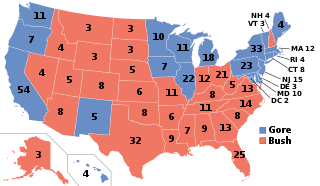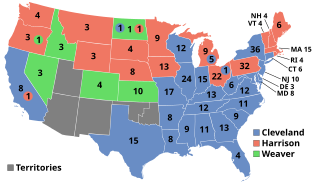
Presidential elections were held in the United States on November 7, 2000. Republican nominee Governor George W. Bush of Texas, the eldest son of 41st U.S. President George H. W. Bush, narrowly defeated incumbent Democratic Vice President Al Gore. It was the fourth of five U.S. presidential elections, and the first since 1888, in which the winning candidate lost the popular vote, and is considered one of the closest U.S. presidential elections in history, with long-standing controversy about the result. Gore conceded the election on December 13 after the Supreme Court issued its decision.

Short-track speed skating is a form of competitive ice speed skating. In competitions, multiple skaters skate on an oval ice track with a length of 111.111 metres (364.54 ft). The rink itself is 60 metres (196.85 ft) long by 30 metres (98.43 ft) wide, which is the same size as an Olympic-sized figure skating rink and an international-sized ice hockey rink. Related sports include long-track speed skating and inline speed skating.

Presidential elections were first held in the United States from December 15, 1788 to January 7, 1789, under the new Constitution ratified in 1788. George Washington was unanimously elected for the first of his two terms as president and John Adams became the first vice president. This was the only U.S. presidential election that spanned two calendar years without a contingent election and the first national presidential election in American history.

Presidential elections were held in the United States from November 1 to December 4, 1816. In the first election following the end of the War of 1812, Democratic-Republican candidate James Monroe defeated Federalist Rufus King. The election was the last in which the Federalist Party fielded a presidential candidate.

Presidential elections were held in the United States on November 8, 1892. In the fourth rematch in American history, the Democratic nominee, former president Grover Cleveland, defeated the incumbent Republican President Benjamin Harrison. Cleveland's victory made him the first president in American history to be elected to a non-consecutive second term, a feat not repeated until Donald Trump was elected in 2024. This was the first of two occasions when incumbents were defeated in consecutive elections—the second being Gerald Ford's loss in 1976 to Jimmy Carter followed by Carter's loss in 1980 to Ronald Reagan. The 1892 election saw the incumbent White House party defeated in three consecutive elections, which did not occur again until 2024.

Presidential elections were held in the United States on November 3, 1964, less than a year following the assassination of John F. Kennedy, who won the previous presidential election. Incumbent Democratic President Lyndon B. Johnson defeated Republican Senator Barry Goldwater in a landslide victory. Johnson was the fourth and most recent vice president to succeed the presidency following the death of his predecessor and win a full term in his own right. Johnson won the largest share of the popular vote for the Democratic Party in history at 61.1%. As of 2024, this remains the highest popular vote percentage of any candidate since the advent of widespread popular elections in 1824.

The 1918 United Kingdom general election was called immediately after the Armistice with Germany which ended the First World War, and was held on Saturday, 14 December 1918. The governing coalition, under Prime Minister David Lloyd George, sent letters of endorsement to candidates who supported the coalition government. These were nicknamed "Coalition Coupons", and led to the election being known as the "coupon election". The result was a massive landslide in favour of the coalition, comprising primarily the Conservatives and Coalition Liberals, with massive losses for Liberals who were not endorsed. Nearly all the Liberal MPs without coupons were defeated, including party leader H. H. Asquith.

The 1864–65 United States House of Representatives elections were held on various dates in various states between June 5, 1864, and November 7, 1865, in the midst of the American Civil War and President Abraham Lincoln's reelection. Each state set its own date for its elections to the House of Representatives. Members were elected before the first session of the 39th United States Congress convened on December 4, 1865, including the at-large seat from the new state of Nevada, and the 8 from Tennessee, the first secessionist state to be readmitted. The other 10 secessionist states had not yet been readmitted, and therefore were not seated.

Handball at the Summer Olympics refers to two different sports. Field handball was introduced for men at the 1936 Summer Olympics in Berlin, but dropped after that. At the 1952 Olympics, field handball was a demonstration sport. (Indoor) handball was introduced for men at the 1972 Summer Olympics in Munich. Women's handball competition was introduced at the 1976 Summer Olympics in Montreal.
The Associated Press poll provides weekly rankings of the top 25 NCAA teams in one of three Division I college sports: football, men's basketball and women's basketball. The rankings are compiled by polling 62 sportswriters and broadcasters from across the nation. Each voter provides their own ranking of the top 25 teams, and the individual rankings are then combined to produce the national ranking by giving a team 25 points for a first place vote, 24 for a second place vote, and so on down to 1 point for a twenty-fifth place vote. Ballots of the voting members in the AP poll are publicized.

Presidential elections were held in the United States on November 8, 2016. The Republican ticket of businessman Donald Trump and Indiana governor Mike Pence defeated the Democratic ticket of former secretary of state and former first lady Hillary Clinton and Virginia junior senator Tim Kaine, in what was considered one of the biggest political upsets in American history. It was the fifth and most recent presidential election in which the winning candidate lost the popular vote. It was also the sixth and most recent presidential election in U.S. history in which both major party candidates were registered in the same home state.

Presidential elections were held in the United States on November 3, 2020. The Democratic ticket of former vice president Joe Biden and the junior U.S. senator from California Kamala Harris defeated the incumbent Republican president Donald Trump, and vice president Mike Pence. The election took place against the backdrop of the global COVID-19 pandemic and related recession. The election saw the highest voter turnout by percentage since 1900. Biden received more than 81 million votes, the most votes ever cast for a presidential candidate in U.S. history.

Since being admitted to the Union in 1850, California has participated in 43 presidential elections. A bellwether from 1888 to 1996, voting for the losing candidates only three times in that span, California has become a reliable state for Democratic presidential candidates since 1992.

Presidential elections were held in the United States on November 5, 2024. The Republican Party's ticket—Donald Trump, who was the 45th president of the United States from 2017 to 2021, and JD Vance, the junior U.S. senator from Ohio—defeated the Democratic Party's ticket—Kamala Harris, the incumbent vice president, and Tim Walz, the governor of Minnesota. Trump and Vance are scheduled to be inaugurated as the 47th president and the 50th vice president on January 20, 2025, after their formal election by the Electoral College.
The 1901 New South Wales state election was for 125 electoral districts, with each district returning one member. The election was conducted on the basis of a simple majority or first-past-the-post voting system. In this election, in 32 electorates the winning candidate received less than 50% of the votes, while 13 were uncontested. The average number of enrolled voters per electorate was 2,764, ranging from Wentworth (1,706) to Willoughby (4,854).
The 1887 New South Wales colonial election was for 124 members representing 74 electoral districts. The election was conducted on the basis of a simple majority or first-past-the-post voting system. In this election there were 35 multi-member districts returning 87 members and 37 single member districts giving a total of 124 members. In the multi-member districts each elector could vote for as many candidates as there were vacancies. 13 districts were uncontested. This was the first election at which there were recognisable political parties. The average number of enrolled voters per seat was 1,984, ranging from Boorowa (1,103) to Canterbury (3,161).
The 1885 New South Wales colonial election was for 122 members representing 72 electoral districts. The election was conducted on the basis of a simple majority or first-past-the-post voting system. In this election there were 35 multi-member districts returning 85 members and 37 single member districts giving a total of 122 members. In the multi-member districts each elector could vote for as many candidates as there were vacancies. 7 districts were uncontested. There was no recognisable party structure at this election. The average number of enrolled voters per seat was 1,831, ranging from East Maitland (1,018) to Canterbury (2,630).
The 1882 New South Wales colonial election was for 113 members representing 72 electoral districts. The election was conducted on the basis of a simple majority or first-past-the-post voting system. In this election there were 32 multi-member districts returning 73 members and 40 single member districts. In the multi-member districts each elector could vote for as many candidates as there were vacancies. 13 districts were uncontested. There was no recognisable party structure at this election. The average number of enrolled voters per seat was 1,701, ranging from East Maitland (984) to Wentworth (2,977).
The 1880 New South Wales colonial election was for 108 members representing 72 electoral districts. The election was conducted on the basis of a simple majority or first-past-the-post voting system. In this election there were 29 multi-member districts returning 68 members and 43 single member districts. In the multi-member districts each elector could vote for as many candidates as there were vacancies. 14 districts were uncontested. There was no recognisable party structure at this election. The average number of enrolled voters per seat was 1,549 for a country seat and 2,361 for an urban one, ranging from East Maitland (966) to Bourke (3,478).













